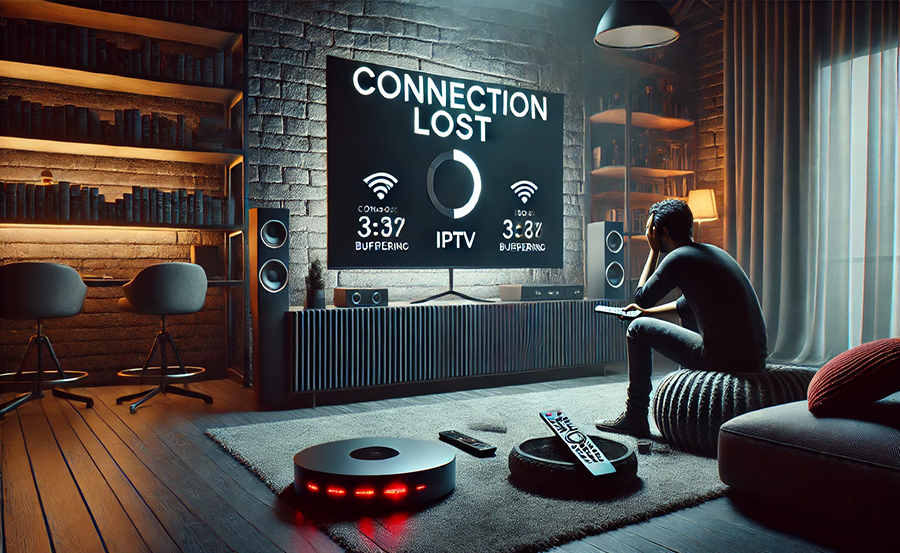
Ever pondered over the seamless journey of television magic as it effortlessly traverses the realms of the internet,How IPTV Works delivering your beloved shows and movies with just a click? The revelation lies within the captivating domain of IPTV, where technology intertwines with entertainment in unprecedented ways. Delving into the mechanics of IPTV, we unravel the mysteries behind its operation and examine why it stands as a transformative force in the realm of digital content delivery.
IPTV harnesses internet protocols to directly deliver television content to your device, presenting a dynamic alternative to traditional broadcasting approaches. The seamless fusion of internet technology with television not only elevates accessibility but also unlocks a plethora of possibilities in the ever-evolving landscape of digital entertainment. As we probe deeper into the inner workings of IPTV, we unearth the mechanisms propelling this technological marvel and scrutinize its impact on our media consumption habits.
BUY Iptv subscription
Eager to unravel the intricate details of IPTV and its influence on the future of entertainment? Join us on this exploration as we navigate through the realms of bytes and pixels, unveiling the enchantment that fuels the television experience of the digital age. However, this is merely the tip of the iceberg; a vast expanse of knowledge awaits regarding IPTV and its potential to reshape our connection with the world of entertainment. So, fasten your seatbelts as we embark on a journey into the heart of IPTV, guided by insights from leading experts in the field.

Basics of IPTV
What is IPTV?
At its core, IPTV is a method of delivering television content through the Internet Protocol (IP) rather than traditional cable or satellite means. This innovative technology leverages the power of the internet to transmit television signals, allowing users to access their favorite channels and content in a more flexible and personalized manner.
To become iptv reseller
How Does IPTV Work?
IPTV, or Internet Protocol Television, is a system through which television services are delivered using the Internet Protocol (IP) over a packet-switched network, such as the internet, instead of being delivered through traditional terrestrial, satellite, and cable television formats. Here’s a basic overview of how IPTV works:
Content Sources:
IPTV services obtain content from various sources, including live TV channels, on-demand content libraries, and sometimes recorded programming.
HD IPTV Stream How to Watch High-Quality TV Channels Online
Encoding and Compression:
Before the content is transmitted over the internet, it undergoes encoding and compression to reduce the file size and make it suitable for streaming. Common compression standards include H.264 and H.265.
Content Delivery:
The compressed content is then delivered to the end-users through a broadband connection. This can be a high-speed internet connection provided by an Internet Service Provider (ISP).
IPTV Middleware:
IPTV middleware is the software that manages the IPTV system. It’s responsible for content delivery, user authentication, and overall system control. Middleware ensures that the right content is delivered to the right user at the right time.
User’s Set-Top Box or Smart TV:
Users need a device to access and decode the IPTV content. This can be a dedicated IPTV set-top box or a smart TV that is IPTV-enabled. Some IPTV services also offer apps for various devices, including smartphones, tablets, and computers.
User Request and Control:
Users interact with the IPTV service through a user interface provided by the set-top box or smart TV. This interface allows users to select channels, browse through on-demand content, and control playback.
Internet Connection:
A stable and sufficiently fast internet connection is crucial for uninterrupted IPTV streaming. Higher quality content (e.g., high-definition channels) typically requires a faster internet connection to ensure smooth playback.
Streaming Protocols:
IPTV services use streaming protocols such as Real-Time Messaging Protocol (RTMP), Real-Time Streaming Protocol (RTSP), or Hypertext Transfer Protocol (HTTP) to deliver content to users in real-time.
On-Demand and Live Streaming:
IPTV supports both live streaming (simultaneous broadcasting of TV channels) and on-demand streaming (users can request and watch content whenever they want).
Quality of Service (QoS) Management:
IPTV providers often implement Quality of Service measures to ensure a reliable and consistent viewing experience. This includes minimizing buffering, optimizing video quality, and reducing latency.
Navigating the IPTV Landscape
Types of IPTV Services
IPTV services come in various forms, catering to the diverse preferences of users. The three primary types are:
Live Television IPTV: This type allows users to stream live broadcasts in real-time, mimicking the traditional TV experience.
Time-Shifted IPTV: With time-shifted IPTV, users can access content that has been broadcasted in the past. This feature grants unparalleled flexibility, enabling viewers to watch their favorite shows at their convenience.
Video on Demand (VOD): VOD services empower users to choose what they want to watch and when. This on-demand feature ensures a personalized viewing experience.
Unlocking the Power of Roku Devices: Streaming Simplified
The Technological Marvels Behind IPTV
Compression Algorithms
To facilitate smooth transmission, IPTV relies on advanced compression algorithms. These algorithms reduce the size of digital signals without compromising quality, ensuring that data can be efficiently transmitted over the internet.
Internet Bandwidth
A crucial factor in the functioning of IPTV is internet bandwidth. Higher bandwidth translates to faster and more stable connections, minimizing buffering and optimizing the overall viewing experience. As technology progresses, the demand for increased bandwidth becomes more pronounced.
Multi-Protocol Label Switching (MPLS)
MPLS is a technology that enhances the performance and efficiency of data transmission in IPTV networks. It enables the creation of virtual private networks (VPNs), ensuring secure and seamless content delivery.
Advantages of IPTV
IPTV, or Internet Protocol Television, offers several benefits that contribute to its growing popularity. Here are some key advantages:
Wide Range of Content:
IPTV provides access to a vast array of content, including live TV channels, on-demand movies, TV shows, and exclusive programming. Users can choose from a diverse selection of channels and content libraries.
Interactive Features:
Many IPTV services offer interactive features such as video on demand (VOD), electronic program guides (EPG), and interactive advertising. Users can control what they watch and when, enhancing their overall viewing experience.
Flexibility and Convenience:
IPTV allows users to watch their favorite content on various devices, including smart TVs, computers, smartphones, and tablets. This flexibility enables users to enjoy television on their terms, regardless of location.
Time-Shifted Viewing:
With IPTV, users can often access time-shifted viewing, which means they can watch programs that have already aired. Features like DVR (Digital Video Recorder) functionality enable users to record and watch content at their convenience.
High-Quality Video and Audio:
IPTV can deliver high-quality video and audio, including high-definition (HD) and even 4K content. This is particularly appealing to users who seek an enhanced viewing experience with superior picture and sound quality.
Cost-Effective:
IPTV can be a cost-effective solution for consumers compared to traditional cable or satellite TV services. Many IPTV services offer competitive pricing and flexible subscription plans, allowing users to choose the channels and features they want.
Global Accessibility:
Since IPTV is delivered over the internet, it has global accessibility. Users can access content from anywhere with an internet connection, making it a convenient option for travelers or individuals living in different regions.
Multi-Screen Viewing:
IPTV supports multi-screen viewing, allowing users to watch different channels or content on multiple devices simultaneously. This feature is particularly useful for households with multiple viewers and diverse content preferences.
Regular Updates and Upgrades:
IPTV services can be updated and upgraded regularly to provide users with new features, improved performance, and access to the latest content. This helps in keeping the service technologically up-to-date.
Reduced Hardware Requirements:
IPTV eliminates the need for traditional cable or satellite TV infrastructure, as it relies on existing internet connections. This can result in reduced hardware requirements and associated costs for both service providers and consumers.
Challenges of IPTV
While IPTV offers numerous benefits, it also faces several challenges. Here are some common challenges associated with IPTV:
- Bandwidth Limitations:
IPTV relies on internet bandwidth to deliver content. In areas with limited or unreliable internet connectivity, users may experience buffering, lower video quality, or service interruptions.
- Network Congestion:
During peak usage times, network congestion can occur, leading to slower internet speeds and degraded IPTV performance. This can result in buffering, delays, or a reduction in video quality.
- Quality of Service (QoS) Issues:
Maintaining consistent quality of service can be challenging, especially in environments where network conditions fluctuate. Factors such as latency, jitter, and packet loss can impact the user experience.
- Content Licensing and Copyright Issues:
IPTV providers must navigate complex content licensing agreements and adhere to copyright regulations. Securing rights to broadcast certain channels or content can be a cumbersome and expensive process.
- Security Concerns:
IPTV services are susceptible to unauthorized access, content piracy, and illegal distribution. Protecting content from piracy and ensuring secure transmission are ongoing challenges for IPTV providers.
- Integration with Legacy Systems:
In some cases, integrating IPTV with existing cable or satellite systems can be complex. This is especially true for traditional broadcasters looking to transition to IPTV, as they may face challenges in adapting their infrastructure.
- User Equipment Compatibility:
Users must have compatible devices, such as IPTV-enabled smart TVs or set-top boxes, to access IPTV services. Ensuring widespread adoption of compatible devices can be a hurdle for IPTV providers.
- Service Reliability:
IPTV services need to maintain high reliability to ensure a seamless viewing experience. Technical issues, server outages, or software glitches can lead to service disruptions and dissatisfaction among users.
- Regulatory Compliance:
IPTV providers must adhere to various regulatory requirements, including those related to content distribution, privacy, and consumer protection. Navigating these regulations can be complex and may vary by region.
- Competition and Market Saturation:
The IPTV market is highly competitive, with numerous providers vying for subscribers. Differentiating services and attracting and retaining customers in a saturated market pose ongoing challenges.
- Content Delivery Costs:
Delivering high-quality video content, especially in HD or 4K resolutions, can incur significant bandwidth and storage costs for IPTV providers. Balancing these costs while maintaining affordable subscription plans is a constant challenge.
- User Education:
Some users may be unfamiliar with the concept of IPTV, and there might be a need for education on how to set up and use the service. This requires effective communication and support from service providers.
Key Elements of User-Friendly IPTV
Creating a user-friendly IPTV (Internet Protocol Television) experience involves several key elements to ensure that viewers can easily navigate and enjoy the content. Here are some essential elements for a user-friendly IPTV service:
- Intuitive User Interface (UI):
Design a clean and intuitive user interface that is easy to navigate. Ensure that users can quickly access live channels, on-demand content, and additional features without confusion.
- Easy Navigation:
Implement straightforward navigation menus and controls. Users should be able to easily browse through channel lists, switch between live and on-demand content, and access settings without encountering complexity.
- Responsive Design:
Ensure that the IPTV service is responsive across different devices and screen sizes. Whether users are accessing content on a smart TV, tablet, smartphone, or computer, the interface should adapt seamlessly.
- Personalized Recommendations:
Provide personalized content recommendations based on users’ viewing history and preferences. This enhances the user experience by suggesting content that aligns with individual tastes.
- Search Functionality:
Include a robust search function that allows users to quickly find specific channels, shows, or movies. Incorporate filters and sorting options to make the search process more efficient.
- Customizable User Profiles:
Enable users to create individual profiles with personalized settings and preferences. This is especially useful in households with multiple viewers, allowing each user to have their own unique experience.
- Parental Controls:
Implement robust parental control features to allow parents to restrict access to certain content based on its rating or category. This ensures a family-friendly viewing experience.
- Reliable Playback:
Ensure reliable and smooth video playback. Minimize buffering and optimize streaming quality to provide a seamless viewing experience, especially for high-definition content.
- Interactive Program Guide (EPG):
Include an interactive electronic program guide (EPG) that displays current and upcoming programming. Users should be able to easily browse through the schedule and set reminders for their favorite shows.
- Multi-Screen Support:
Offer support for multi-screen viewing, allowing users to watch content on different devices simultaneously. Sync viewing progress across devices for a seamless transition.
- Offline Viewing (Download and Play):
If feasible, provide users with the option to download content for offline viewing. This is particularly useful for users who may not always have a reliable internet connection.
- Customer Support and Help Resources:
Include easily accessible customer support options and help resources. This can include FAQs, tutorials, and responsive customer support channels to assist users with any issues or inquiries.
- Regular Updates and Feature Enhancements:
Keep the IPTV platform up-to-date with regular updates and introduce new features to enhance the user experience. Inform users about updates and improvements to keep them engaged.
- Accessible Settings and Preferences:
Make settings and preferences easily accessible. Users should be able to customize settings related to video quality, audio, subtitles, and other features to tailor the viewing experience to their liking.
Exploring the Future of IPTV
As technology continues its relentless march forward, the future of IPTV holds exciting possibilities. From advancements in streaming quality to the integration of augmented reality (AR) and virtual reality (VR), the landscape of IPTV is poised for continual evolution.
Conclusion
In the dynamic realm of digital entertainment, understanding how IPTV works is not merely an exploration of technology but an immersion into a future where users dictate their viewing experiences. From the intricacies of data transmission to the unparalleled interactivity it offers, IPTV stands as a testament to the boundless potential of the digital age.
As we navigate the vast sea of content options, IPTV emerges as a beacon of innovation, transforming the way we consume media and paving the way for a more personalized and engaging entertainment landscape. Embrace the future, embrace IPTV, and unlock a world of limitless possibilities at the touch of your fingertips.



